| 1 | Eyelash viper |
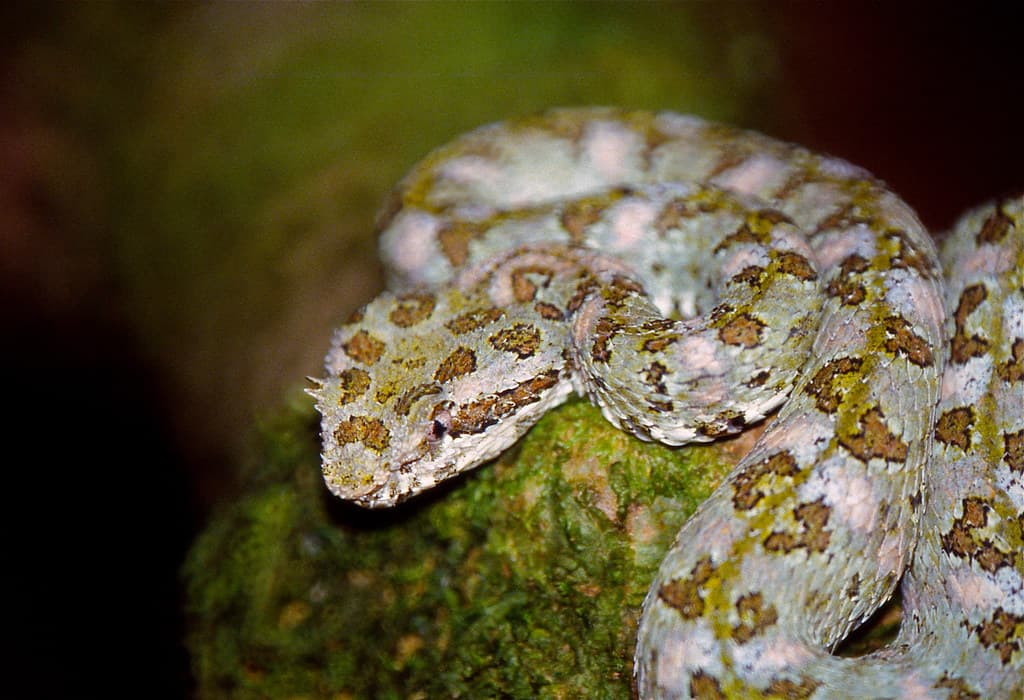
Central America is overflowing with pitvipers, each occupying separate habitats to prevent extreme competition. Rattlesnakes prefer moderate to dry areas, while hognose pitvipers (Porthidium family) prefer leafy rainforest floors. Meanwhile, the Bothriechis genus has claimed the niche of tree branches in rainforests. This venomous family ranges from extreme southern Mexico to Ecuador, with their epicentre in Costa Rica, which hosts 5 of 11 species. Eyelash vipers are easily the most common Bothriechis member, covering all the range described above. This is a venomous snake averaging at 37-82cm, which has extreme variety in appearance – they can be banana yellow, mossy grey, or even “Christmas” green-red.
Eyelash vipers typically rest on branches at chest height or above, causing them to strike the chest or arms. Their bites lack neurotoxins and are rarely fatal, but cause swelling and haemorrhaging, or necrosis and lasting deformities in unlucky cases. Haemorrhagic blood blisters are one staple symptom.
Eyelash vipers are also myotoxic, i.e. they attack muscle tissue. In a study on 10 Costa Rican pitvipers, eyelash viper venom ranked first for myotoxicity alongside the fer-de-lance. Luckily, the venom yield is low, at 10-20mg versus 400-500mg for a fer-de-lance (Central America’s deadliest snake).
| 2 | Black-speckled palm pitviper |
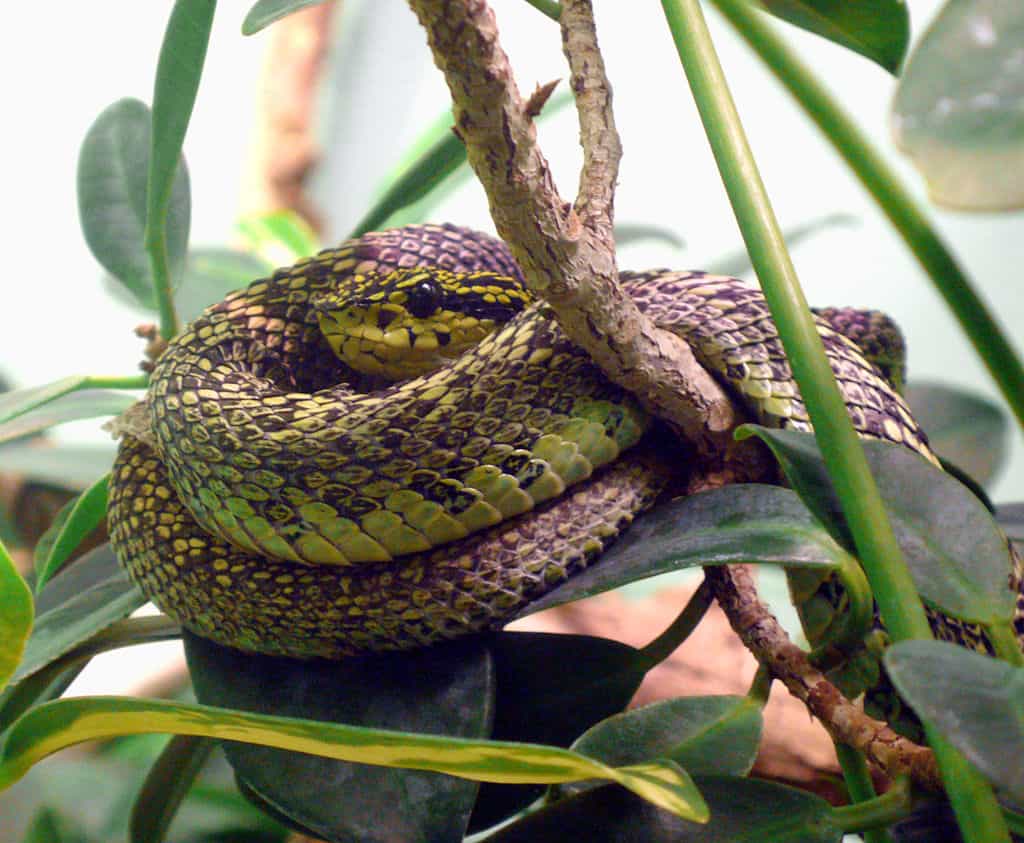
A moderately common snake that inhabits a swathe of Costa Rica, and extreme western Panama. The black-speckled palm pitviper also rests on branches at eye height and higher, but prefers higher altitudes to eyelash vipers. Instead of lowland rainforests, they inhabit sky island mountain ranges including Costa Rica’s Tilarán and Talamanca Cordillera, typically from 1150 metres to 3000 metres.
Bothriechis nigroviridis measures up to 93.7cm, and has a highly separate venom profile to the eyelash viper. Its venom produces no haemorrhaging, minor swelling and coagulant properties, and has moderate myotoxic (muscle-assaulting properties). It’s more lethal overall, one of the most lethal among Bothriechis members.
The reason is a rare neurotoxin called nigroviriditoxin, first discovered in 2015. This makes the black-speckled palm pitviper much more likely to cause paralysis and laboured breathing than its cousins. The further north you travel in Costa Rica, the more these neurotoxins increase; one venom sample consisted of 60.3% nigroviriditoxin. Luckily, an antivenom raised against the South American rattlesnake managed to neutralise the lethal effects of this species. Its venom possesses at least 43 toxins, from 13 families.
| 3 | Side-striped palm pitviper |
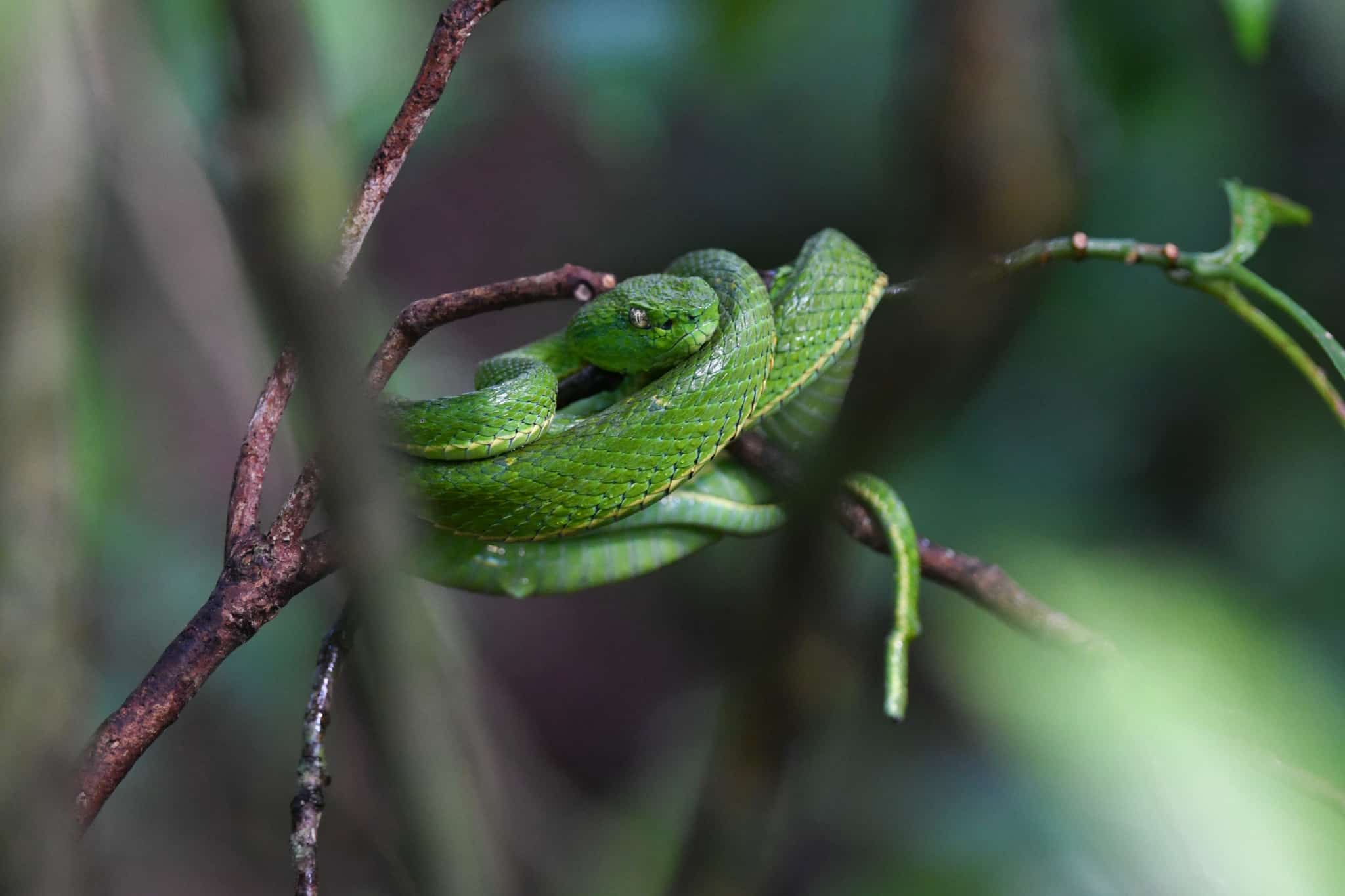
The second most widespread member of the Bothriechis pitviper family. Bothriechis lateralis inhabits most of central Costa Rica, especially the north, and also western Panama. They prefer humid rainforests at moderate altitudes, usually 850 to 2100 metres. Compared to eyelash vipers, this species is nearly always green, with little colour variation. There’s also a thin white (or yellow) stripe on each flank, which eyelash vipers completely lack.
Instead of neurotoxins, the side-striped palm pitviper is likely to trigger haemorrhaging. Its venom consists of 55% snake venom metalloproteinases (SVMPs), which degrade type 4 collagen in blood vessels and cause them to rupture. Luckily, this venom seems relatively easy to cure. There’s no dedicated antivenom, but an antivenom designed against the notorious fer-de-lance combated the toxins, as did one raised against the Central American rattlesnake.
Statistics are hard to come by, but a 1984 report mentioned 41 bites per year in Costa Rica, with no deaths, but often permanent injuries to the hands. While Bothriechis lateralis spends most of its life on branches, females descend to the ground to give birth (as live young). These newborns measure 19.6 to 25.5cm, while adults measure up to 95cm. Younglings prey on leaf litter anoles and Eleutherodactylus frogs, while adults graduate to rodents and even bats.
| 4 | Guifarro’s palm pitviper |
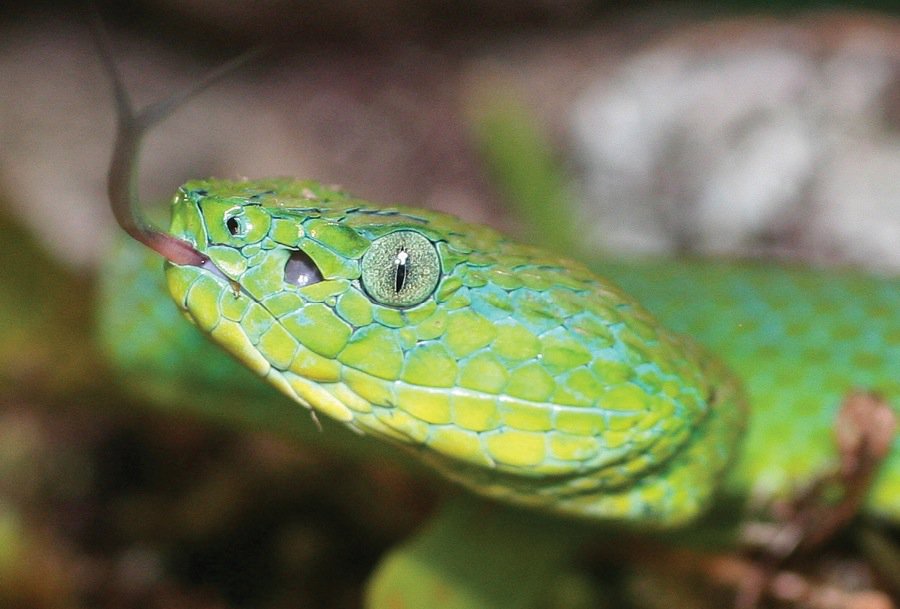
A lot of newly discovered snakes are secretive burrowers which you can understand people missing for hundreds of years. But new pitvipers are occasionally found, and one was Bothriechis guifarroi in 2010. This species is found only in the fragmented cloud forests of northern Honduras, specifically in the Texiguat Wildlife Refuge. This was created in 1987, primarily to protect endangered white-faced monkeys, howler monkeys and jaguars, but also any undiscovered creatures that could be hiding, whether in the towering canopies or bushy undergrowth.
Like its whole family, Bothriechis guifarroi is a branch clinger. As the image above shows, blue skin is often visible between its leafy green scales. All adults are this mainly green colour (including the eyes), but juveniles have two colour phases: one green, and one brown, which eventually converge. Meanwhile, Bothriechis lateralis is always brown as a juvenile, sometimes with red patches, before gaining their standard green as an adult.
Being so new, nothing is known about Bothriechis guifarroi’s venom. So far, the longest measured 76.5cm. The species was named after Mario Guifarro, a gold miner who became a conservationist after watching huge swathes of rainforest being slashed down and converted to cattle ranches. He aimed to secure a parcel of untouched land for the native Tawahka people, to the anger of shadowy businessmen. Guifarro avoided multiple attempts on his life, but was finally ambushed and killed on September 15th 2007.
| 5 | March’s palm pitviper |
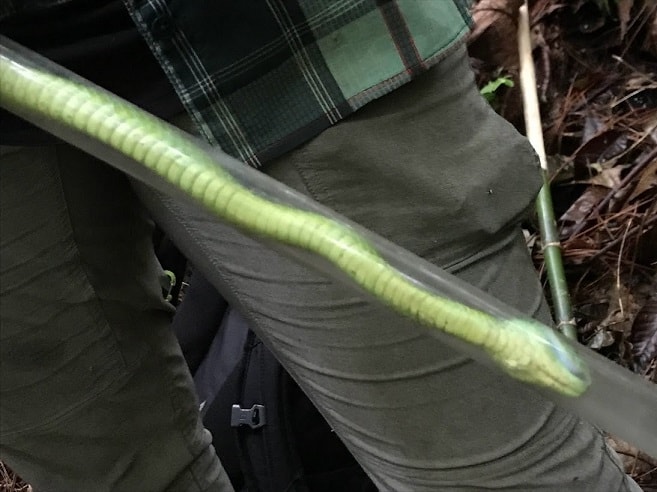
This species lives in one poorly studied region of northwest Honduras, mainly at high altitude forests above 1500 metres. March’s palm pitviper reaches a maximum of 96.5cm, and preys on mammals like Mexican deer mice, and amphibians like Honduras spikethumb frogs.
Bothriechis marchi is an interesting snake. They have a very small range, mainly inhabiting the Sierra de Omoa mountains on the border with Guatemala. It seems like they’re barely clinging onto existence. Yet within hotspots like Cusoco National Park, they’re extremely abundant. At 176 sightings, a 13 year survey found that they were the second most common pitviper inside after Wilson’s montane pitviper (513). They were far more common than eyelash vipers (5) and fer-de-lances (5).
March’s palm pitvipers are fully arboreal and rarely stray to the ground. Dense closed canopy forests are their favourite, typically close to a stream. This seems to be one of the highest climbing Bothriechis members, as a 2022 study that their average perch height when tracked by radiotransmittor was 17.04 metres above ground. The average temperature of observations was 15C, relatively cool. One of the March’s palm pitvipers the scientists tracked stayed completely still for several weeks. Like all Bothriechis members, this is a committed ambush hunter. Another special feature is a fluorescent tail tip they use to lure in curious prey.
| 6 | Yellow-blotched palm pitviper |
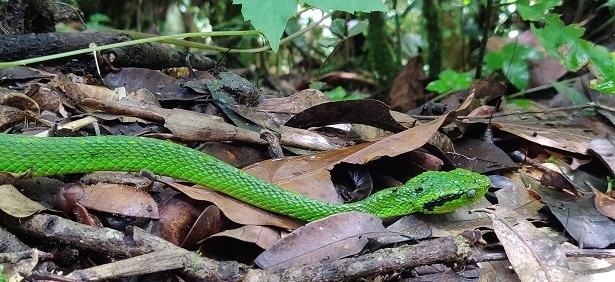
This venomous branch snake mainly inhabits central and northwestern Guatemala, also a tiny portion of Chiapas, Mexico just over the border. Like March’s palm pitviper, it has a narrow range, yet is abundant in certain spots, particularly in the hills surrounding the town of Tactic.
The yellow-blotched palm pitviper (Bothriechis aurifer) reaches a maximum of 100cm. This is one of the more recognisable Bothriechis members, as there’s nearly always a thick black marking extending from the eye. They’re nearly always green, and then there’s a spinal pattern consisting of broken yellow blotches with a black outline, which is found in over 50% of individuals (see here). Its venom was studied in 2017, and revealed to consist of 33-39% metalloproteinases, with a helping of CRISP toxins and bradykinin-potentiating peptides. This is closer to eyelash vipers and B. lateralis, shunning the neurotoxic profile of the black-speckled palm pitviper. Bite reports are few, but with this toxin makeup, swelling and moderate haemorrhaging is likely.
Yellow-blotched palm pitvipers live at 1200-2300 metres above sea level, though a few strays have appeared lower. Their habitats are the same as most Bothriechis: moist forests with a closed canopy, preferably near a stream. Don’t search for this species in a desert or on a grassy hillside; you’ll just stumble into a rattlesnake’s lair instead.
| 7 | Guatemala palm pitviper |
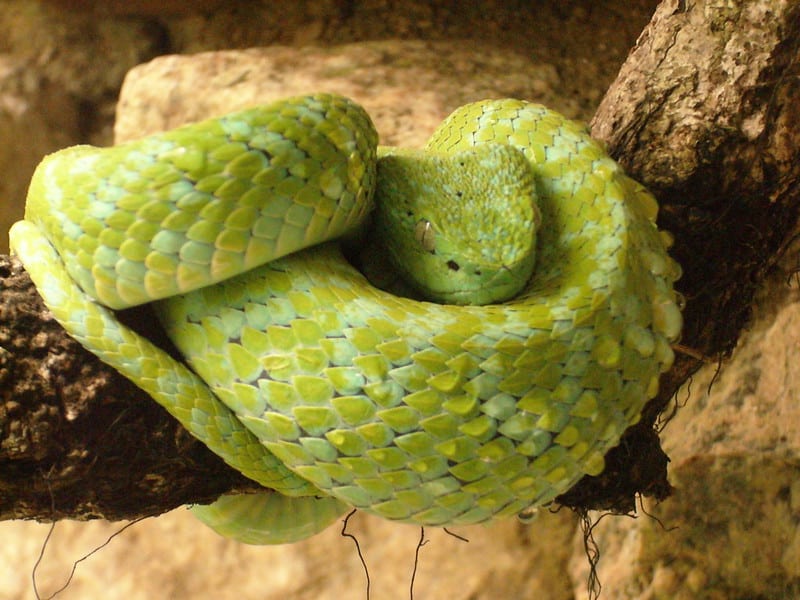
A palm pitviper species with virtually no research to its name. Similarly to Bothriechis aurifer, this species straddles the border between Guatemala and Mexico, but lives much further south and has no overlap. They prefer foothills between 900 and 2090 metres, and adults are green with occasional blue speckles. Sometimes the blue is missing, but in others, they’re fully fledged neon stripes (see here).
There isn’t a single detailed bite report for this pitviper, although local Guatemalan villagers have doubtlessly been bitten without realising how rare this species is. What we know so far is that its venom differs from the nearby Bothriechis marchi and B. aurifer.
Unlike the latter, which contains virtually none, 35.2% of its venom consists PLA2s, divided into two toxins. There were far fewer metalloproteases than other Bothriechis members. We still don’t know the implications, as PLA2s are very diverse, and can act as haemotoxins, myotoxins and neurotoxins alike.
Either way, it’s wise to stay away. Bothriechis bicolor reaches a maximum of 100cm, and is most commonly observed at 2-3 metres above ground on a branch.
| 8 | Blotched palm pitviper |
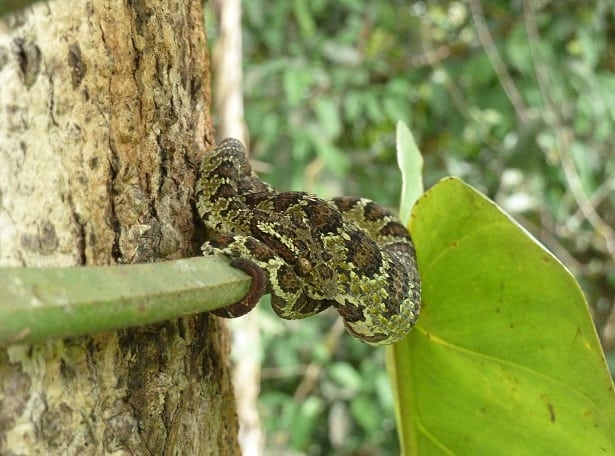
The blotched palm pitviper (Bothriechis supraciliaris) is found only in Costa Rica, and has blotchy patterns rather than a clean jungle green. They also possess the elevated mini horns of the more common eyelash viper, their closest relative. They’re easy to confuse with eyelash vipers, but with Bothriechis supraciilaris, the blotches are more clearly defined, with less messy patterns inbetween. They also appear at high elevations than eyelash vipers, usually from 800-1700 metres.
Blotched palm pitvipers are one of the more flexible members. They appear in dense forests with closed canopies, but also regenerating forests damaged by mankind, and even the edges of farm fields, with sufficient vegetation. While still a branch clinger, they spend relatively more time on the ground.
Bothriechis supraciliaris is relatively short, maxing out at 58.3cm. They can be jungle green, but have an especially common morph which is paler mint-green, overlaid with brown spinal blotches. Venom analysis revealed weak pro-coagulant activity, moderate myotoxicity, and strong haemorrhaging properties, with no mention of neurotoxins. It was relatively non-lethal, and easily neutralised by a standard viper antivenom.
| 9 | Rowley’s palm pitviper |
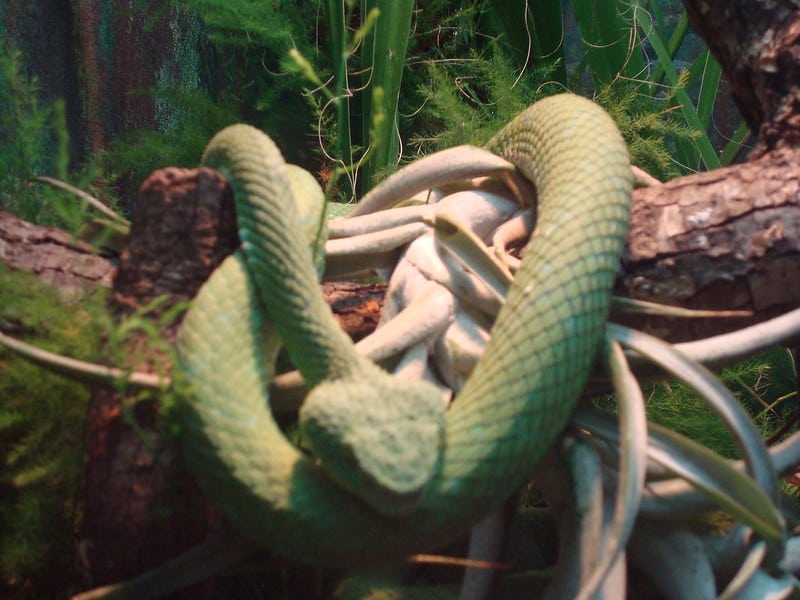
Also known as the blue-tailed palm pitviper. This is another ultra rare species, known from just a few localities in Chiapas and Oaxaca states, extreme southeast Mexico. Its territory is shrinking all the time, with its native cloud forests being pushed back by the march of deforestation. Bothriechis rowleyi is anther high altitude pitviper, ranging from 1096 to 1830 metres.
Bothriechis rowleyi can’t stand meadows, rocky hillsides, and farmyard, and an urban town would be as appealing as Mordor to them. Dense, untouched forests are only sanctuary. With its occasional blue patches, this species looks similar to the Guatemalan palm pitviper a few hundred miles away. But there’s one easy ID sign: yellow eyes rather than green.
This species was discovered by J. S. Rowley, who died just a few months after its discovery when he fell off a cliff in Sierra de Cuatro Venados (also Oaxaca state). The original snake was discovered after a hummingbird was spotted flying frantically near palm thickets, perhaps in a desperate escape. Virtually nothing is known about this species’ venom. They’re one of the longer members at a maximum of 97.3cm.
| 10 | Talamancan palm pitviper |

The rarest Bothriechis pitviper in Costa Rica. This species measures 93.7cm as a maximum so far, and has the usual branch-dwelling ways.
To find this venomous forest dweller, you’ll have to hike deep into the Talamanca Cordillera on the border with Panama, a pristine realm of tiny farming communities and obscure hiking trails. This species was only made official in 2016. The first specimen was discovered in 2001, but was so similar to the black-speckled palm pitviper that it was assumed to be the same species. According to the initial discovery, the Talamancan palm pitviper (Bothriechis nubestris) inhabits the transition zone between cloud forest and montane rainforest, and had only been found between 2400 and 3000 metres. The Latin title nubestris translates as “belonging to the clouds”.
Talamancan palm pitvipers share the neurotoxic nigroviriditoxin of their cousin, but in far smaller percentages: 0.7% versus up to 60.3%. Instead, this has a more typical Bothriechis venom, specialising in haemorrhaging, with snake venom metalloproteinases (SVMPs) contributing the most toxins at 34.9%. There’s also a PLA2 making up 15.7%, which structurally resembles a known myotoxin (muscle-assaulting toxin) in eyelash viper venom.
Together, Bothriechis nubestris and B. nigroviridis are believed to have diverged from the other Bothriechis members 7.5-13 million years ago. They then separated from each other approximately 6-10 MYA, barely changing in appearance, but diverging in their venom. Somehow, B. nigroviridis accumulated a war chest of neurotoxins after diverging, while the Talamancan palm pitviper didn’t bother.
Meanwhile, the common ancestor of the entire Bothriechis family apparently appeared 18 MYA. Eyelash vipers (B. schlegelli) and blotched palm pitvipers (B. supracillis) split from the other nine the earliest, diverging well over 10 million years ago.
